Welcome to a celebration of the life and art of Paul Gauguin
You are invited to discover the many facets of a complex and insightful man. Paul Gauguin is unveiled through what we learn about his life, his struggles and the soul of a brilliant man celebrated by a chamber opera which stages his progressive and innovative essence.
“Bonjour M. Gauguin” is a unique combination of paintings and music which brings to life the beauty unexpectedly discovered in the painter’s insights, correspondence and artistic commentary. These rare and largely unknown writings, which expose Paul Gauguin’s literary talent as well as his artistic brilliance, were recovered after extensive research and shed light on the complexity, controversy and poetry of Gauguin. His very words gave birth to the opera and libretto itself, perhaps the first time in musical history that a theatrical portrayal is self-defined by the subject: Paul Gauguin in his own words set to music by composer Fabrizio Carlone.
The music, written in constant confrontation with these marvelous texts, dense with poetic imagery and artistic vision, gives life to an opera with a distinctive relationship between music and texts. The extraordinary experience of full immersion into a comprehensive universe of art, music and poetry is extended to the listener. In participating in this great human and artistic adventure, one is lured into sharing individual feelings with those of Gauguin, opening one’s mind to a new musical landscape.
Of the five vocalists, both baritone and soprano interpret the character of Gauguin. The rich variety of the painters’ writing inspired the creation of the two roles portraying Gauguin, at times full of bold sarcastic controversy and at others full of carefree, artistic vision.
Through this device the full range of literary colours have been voiced in an innovative portrayal. The other three voices (mezzo-soprano, tenor and bass) depict Gauguin’s contemporaries, at times narrating the artistic world of the painter.
The scene is set with multi-layered screens on which a video artist creates fresh, original images based on the colours and details of Gauguin’s paintings. The stage is set for Gauguin’s words with a full sensory experience of sounds, lights and colour.
« BONJOUR M. GAUGUIN »
Project for a chamber opera on the life and art of Paul Gauguin
by FABRIZIO CARLONE
“J’aime la Bretagne, j’y trouve le sauvage, le primitif. Quand mes sabots résonnent sur ce sol de granit j’entends le ton sourd, mat et puissant que je cherche en peinture.”
(Lettre de Gauguin à Schuffenecker, 1888)
“I love Brittany; there, I find the wild and the primitive. When my clogs resonate on this granite terrain, I hear the dull, muffled and powerful tone that I seek in painting.”
(Gauguin’s letter to Shuffenecker, 1888)
A NEW CONCEPT IN OPERA
Not many people know how sensitive to music Gauguin was or how much he felt the deep interaction between colors and sounds or how often he referred to music when he was asked to explain the meaning of his paintings:
“Painting is the most expressive among arts….It’s a complete art that summarizes all the others and integrates them. Like the music, it acts on the soul through tones: in painting the relationships among tones are equivalent to the relationship between chords and harmony in music”.
( P. Gauguin, Notes synthétiques, 1884-1885, Cogniat et Rewald 1962, pp.2-3)
“…color in modern painting will assume a musical meaning. Color is vibration and, like music, is able to comprehend all that is more general and indefinite in nature: its inner force”.
(P. Gauguin, Diverses Choses, dans Oviri, écrits d’un sauvage, Ed. Gallimard 1974)
“…everything in my work is calculated….it’s music, if you want! Through chords of lines and colors, on the pretext of any subject taken from life or nature, I achieve symphonies, harmonies that represent nothing absolutely real in the common sense of the term, because they don’t express any idea directly. These harmonies have to make us think like the music makes us think: without the help of ideas or images, but simply through the mysterious affinities existing between our minds and the chords of colors and lines”. (P. Gauguin. , Interview par Eugène Tardieu, L’Echo de Paris, 13/5/1895)
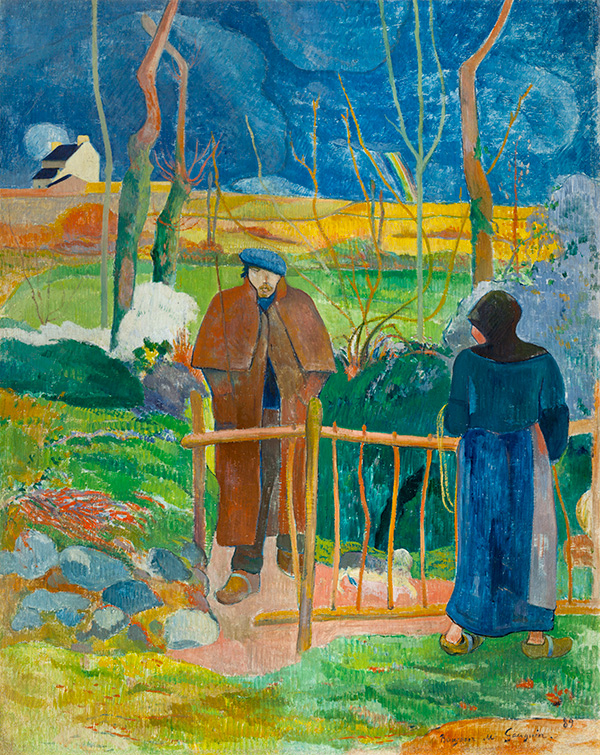
The starting point of the opera is the famous self-portrait entitled: “Bonjour M. Gauguin”. Gauguin gave great importance to this painting: in the exhibition in 1893 at Durand-Ruel’s gallery, where 41 works on Tahiti were exhibited, it was one of the three paintings of the Breton period that he decided to include in the exhibition to let the public comprehend the logic of the development of his art. The self-portrait was painted in Bretagne in 1889, only a few months after the dramatic events of Arles that ended with the Van Gogh’s self-mutilation.
Its subject relates to the self-portrait by the French painter Courbet, entitled “Bonjour M. Courbet”, where the painter shows a quite triumphal encounter of the traveling artist with an admirer and his servant sharing a warm and respectful welcome. Gauguin, in his painting, subverts intentionally the characteristics of Courbet’s painting, depicting a self-portrait that reflects his idea of the artist as a pilgrim. In his picture the painter, wearing a heavy coat and a blue hat, comes toward the observer walking on a path in the Breton countryside. A fence blocks his way and a country-woman, turning her back to the observer, is on the other side of the fence. The “bonjour” the woman says to the artist is the opposite of the emphatic one depicted by Courbet in his self-portrait. In the case of Gauguin it’s a simple “good morning” given by a pesant who by chance crosses the artist’s way: there isn’t any emphasis or rhetoric in it. A fence divides the two figures as if it was a barrier and the dark sky, the heavy clouds, the orange light on the little house on the left, indicate that it has just rained or it will soon rain. The general atmosphere of the painting, the figure of the painter and that of the woman are extremely enigmatic. This mystery represents an interesting component from which the opera sets in motion.
We have imagined that, after the woman greets Gauguin, a conversation between them could begin, and we have imagined that this conversation may have continued not in the painting but, removing the two figures from the painting’s context, somewhere out of space and time.
Gauguin would take his heavy coat and the blue hat off and the peasant woman would do the same with her work clothes, they would come to the foreground, the painting would temporarily disappear, and they would assume, for the duration of the opera, a real aspect. In the painting we cannot see the face of the woman.
Gauguin didn’t give her a precise identity, we decided she could be his interior voice, and that a dialogue could then start between them. By means of this dramaturgical stratagem we intend to closely examine the poetry of the artist and his ideology.
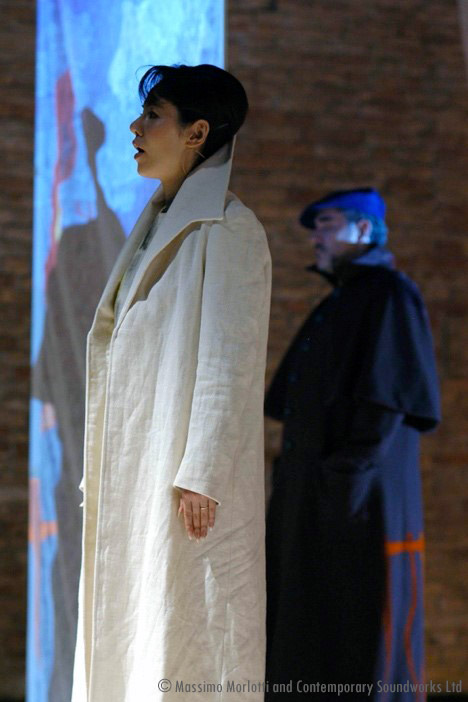
To give brio and sparkle to the performance, and also to clarify some aspects of the artist’s life that may be not well known to the audience, the representation of some biographical moments will come, at times, to suspend the conversation between the painter and the woman. In these moments, an exact time and a precise place will resume. The spotlight on the conversing couple dissolves and new performers will now come on the scene to illustrate episodes from the painter’s life.
The whole opera flows alternating these two situations: the static one, that of the conversation, and the dynamic one, that of the representation of the biographical moments. This dramatic structure will give the opera rhythm and variety and will keep the attention of the audience always alive and focused.
Thanks to the writings Gauguin left, one of the most interesting aspects of this project is the possibility we had to create a libretto using the painter’s real words. As rarely happens, we have therefore the possibility to make the theatrical character sing the real words of the historical figure. The libretto is a result of Gauguin’s authentic literary material once put in order. The opera is sung in French.
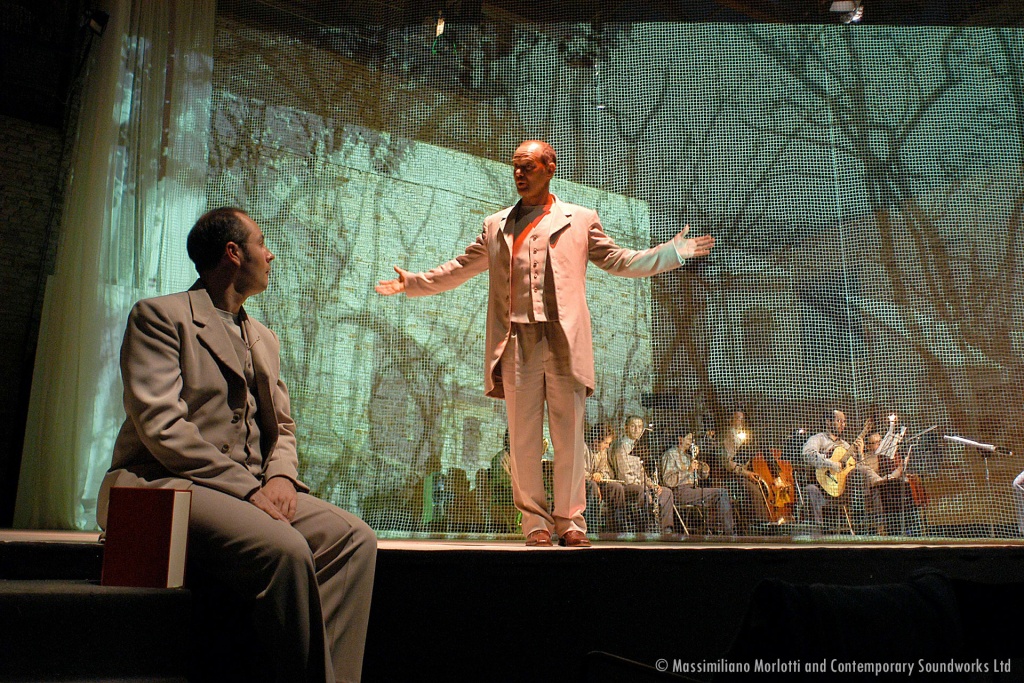
GAUGUIN’S LIFE: AN IDEAL SUBJECT FOR A CONTEMPORARY OPERA
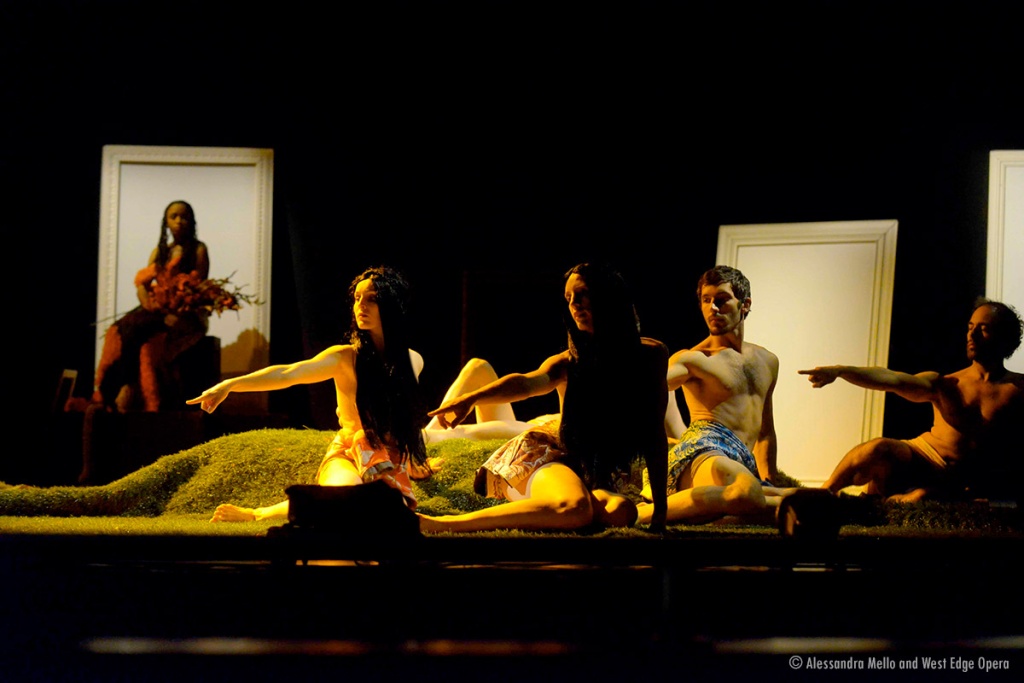
As his artistic experiences, also his life offers us many relevant themes.
The search for the primitive, the exoticism, the escape from western culture pushed him first to Bretagne, then to Martinique, finally to Tahiti and to the Marquesas islands.
Every place added something important to his art but what he pursued, was always more distant.
Did he finally find what he was searching for? No, he didn’t – at least, not entirely.
When Gauguin arrived in Tahiti he didn’t find the primitive island and the native culture from which he wanted to get the energy his work needed. His image of Tahiti and the other islands of Polynesia, was formed by reading tales of 18th century travelers. When he arrived on these islands, towards the end of the 19th century, they had already been colonised for a long time.
What he found was a grotesque copy of what he wanted to escape. Moreover, western culture was permanently canceling the original native culture. He fought against this cultural violence: physically, defending the natives against the French authorities and the Christian Church, but principally through his work, attempting to capture in his paintings the spirit of the natives before it died.
“After such outrageous happenings I had written to the colonial Administrator to ask for an investigation into this matter. I hadn’t believed that the gendarmes were in league with each other to such extent, that the Administrator sided with the Governor. The fact is that the lieutenant sued me and that a villain judge convicted me. This brought upon my ruin and completely wrecked my health.
(P. Gauguin, Lettre à Monfreid, avril 1903, Paris, G. Crès, 1920.)”

In our time we are at the end of a millenary process started long before colonialism. A process that through expanding commerce and, more often, through war, has brought the cultures of the world to confront one another more and more frequently and rapidly. In this sense the experience of Gauguin is a very early and meaningful example: his Spanish-South American origin (he claimed even to have Inca blood), French education, the influence of Japanese art and Tahitian period are all elements that, blended together, contributed to create an art that has a strong multicultural identity.
To create an opera about Paul Gauguin is a way to reflect on his art and life allowing us to broaden our knowledge and consciousness and this chamber opera is intended to be something more than a celebration of Gauguin. It is for us, and hopefully for the public, an occasion to confront ourselves with an enlightened mind.
THE INFLUENCE OF JAPANESE UKIYOE ON GAUGUIN’S ART
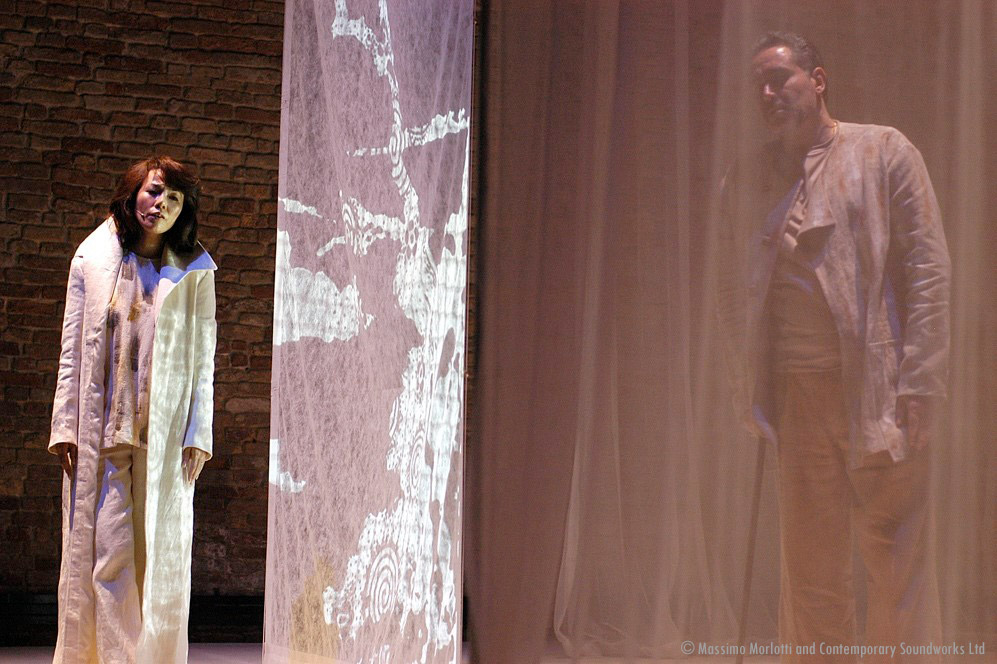
From the correspondence of the painter and according to contemporary evidence, we know that Gauguin loved the Ukiyoe masters. He hung them on the walls of his ateliers and houses, next to reproduction of famous paintings and commended their “superb effect”. He was fascinated by the style of Utamaro and Hokusai, so essentially decorative, under which “one can detect Michelangelo”:
“Japanese sketches, prints of Hokusai, lithographs of Daumier, cruel annotations of Forain, not all accidentally came together in an album of mine, with a clear intention in my mind. I put a photograph of a Giotto next to these prints (…) Next to this warrior of Hokusai, the Saint Michael of Raffaello becomes Japanese (…) Hokusai draws with sincerity. Drawing with sincerity means you don’t lie to yourself.” (P.Gauguin, Avant et Après, in Oviri, écrits d’un sauvage, Ed. Gallimard, Paris, 1974).
Critics have definitely acknowledged the influence of Japanese Ukiyoe on the art of Paul Gauguin. The painter “surely takes from Japanese works the positive simplification of color (…) following the Japanese, he abandoned the reflections and the shadows (…) he framed plain colors with expressive lines suggesting form instead of describing it (…) Like Degas, observing Japanese graphic art, Gauguin understood that drawing is not form, but a way of seeing form. He saw in these images the idea that a painting isn’t a representation of reality but an intellectual way to conceive and translate it: he discovered in these works the fascination of an abstract art”. (Yvonne Thirion, “L’influence de l’estampe Japonaise dans l’oeuvre de Gauguin”, in: Gauguin, Sa vie, son oeuvre, Paris, 1958).
In a letter from Gauguin to Emile Bernard we read:
“Observe the Japanese, who are masters in drawing, you will notice life in open space, under the sun, without shadows. Using colors in various combinations, in distinct harmonies, they give the impression of heat (…) so I would do without anything that gives the appearance of an object and eliminate the shadow that is the false appearance of sunlight”. (P.Gauguin, Letter to Emile Bernard, November, 1888, in Malingue, Lettres de Gauguin à sa femme et à ses amis, Ed. Grasset, Paris, 1946).the


